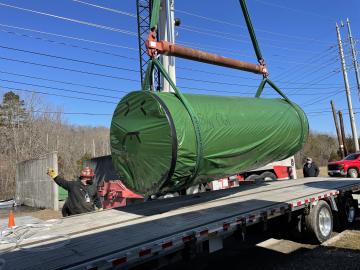
Filter News
Area of Research
- (-) Materials (15)
- (-) Supercomputing (21)
- Advanced Manufacturing (7)
- Biology and Environment (37)
- Building Technologies (1)
- Clean Energy (69)
- Computational Biology (1)
- Computational Engineering (2)
- Computer Science (4)
- Electricity and Smart Grid (1)
- Fusion and Fission (14)
- Fusion Energy (1)
- Isotopes (12)
- Materials for Computing (18)
- Mathematics (1)
- National Security (7)
- Neutron Science (16)
- Nuclear Science and Technology (1)
- Quantum information Science (3)
- Sensors and Controls (1)
- Transportation Systems (1)
News Topics
- 3-D Printing/Advanced Manufacturing (3)
- Artificial Intelligence (3)
- Bioenergy (1)
- Biology (2)
- Biomedical (1)
- Buildings (1)
- Chemical Sciences (2)
- Climate Change (4)
- Composites (1)
- Computer Science (15)
- Coronavirus (2)
- Critical Materials (1)
- Cybersecurity (2)
- Energy Storage (2)
- Environment (6)
- Frontier (3)
- Fusion (1)
- High-Performance Computing (10)
- Isotopes (1)
- ITER (1)
- Machine Learning (1)
- Materials (7)
- Materials Science (7)
- Microscopy (5)
- Nanotechnology (6)
- National Security (1)
- Neutron Science (5)
- Physics (2)
- Polymers (1)
- Quantum Computing (5)
- Quantum Science (5)
- Security (1)
- Space Exploration (1)
- Summit (5)
- Sustainable Energy (1)
- Transportation (1)
Media Contacts

Matthew Ryder has been named an emerging investigator by the American Chemical Society journal Crystal Growth and Design. The ACS recognized him as “one of an emerging generation of research group leaders for his work on porous materials design.”

A team from ORNL, Stanford University and Purdue University developed and demonstrated a novel, fully functional quantum local area network, or QLAN, to enable real-time adjustments to information shared with geographically isolated systems at ORNL

A team led by the ORNL has found a rare quantum material in which electrons move in coordinated ways, essentially “dancing.”

The daily traffic congestion along the streets and interstate lanes of Chattanooga could be headed the way of the horse and buggy with help from ORNL researchers.

A multidisciplinary team of scientists at ORNL has applied a laser-interference structuring, or LIS, technique that makes significant strides toward eliminating the need for hazardous chemicals in corrosion protection for vehicles.

An international problem like climate change needs solutions that cross boundaries, both on maps and among disciplines. Oak Ridge National Laboratory computational scientist Deeksha Rastogi embodies that approach.

Improved data, models and analyses from ORNL scientists and many other researchers in the latest global climate assessment report provide new levels of certainty about what the future holds for the planet

The receipt of a nuclear fuel canister is boosting the research of an Oak Ridge National Laboratory team investigating methods to help the nation effectively dispose of nuclear waste for the long term.

Scientists at ORNL and the University of Tennessee, Knoxville, have found a way to simultaneously increase the strength and ductility of an alloy by introducing tiny precipitates into its matrix and tuning their size and spacing.

An ORNL-led team comprising researchers from multiple DOE national laboratories is using artificial intelligence and computational screening techniques – in combination with experimental validation – to identify and design five promising drug therapy approaches to target the SARS-CoV-2 virus.


